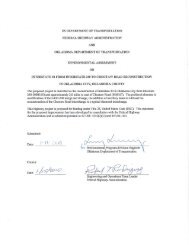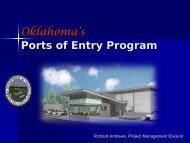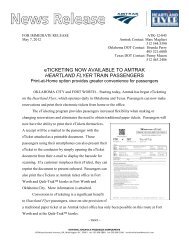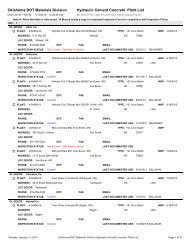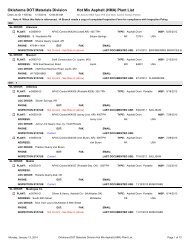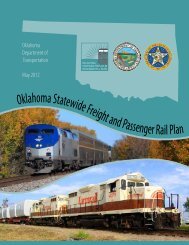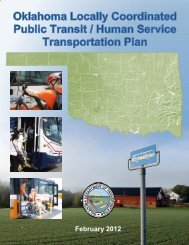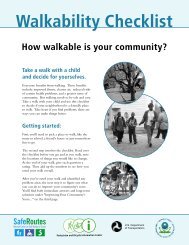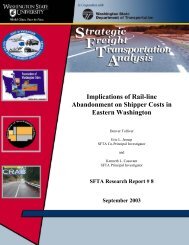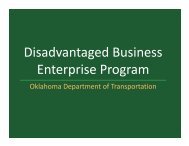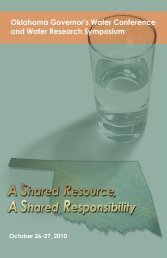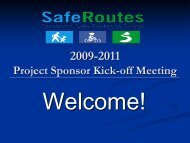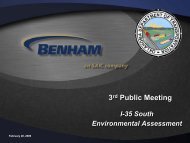Benefit Cost Analysis Technical Memo - Oklahoma Department of ...
Benefit Cost Analysis Technical Memo - Oklahoma Department of ...
Benefit Cost Analysis Technical Memo - Oklahoma Department of ...
Create successful ePaper yourself
Turn your PDF publications into a flip-book with our unique Google optimized e-Paper software.
Cessation <strong>of</strong> service is assumed not to affect the automotive train service provided by A-OK.<br />
This service occurs within the western portion <strong>of</strong> the A-OK and would not be affected by a flood<br />
event closing the line. This service can be maintained with or without the rehabilitation project<br />
<strong>Benefit</strong>s <strong>of</strong> the Project<br />
The primary direct benefits <strong>of</strong> the project result from avoidance <strong>of</strong> the loss <strong>of</strong> freight rail service<br />
currently provided by the A-OK in the <strong>Oklahoma</strong> City – Shawnee corridor, including the access it<br />
provides to the nine-mile BNSF line extending northward from Shawnee. BNSF access to their<br />
line is dependent on trackage rights over the A-OK from <strong>Oklahoma</strong> City. In the absence <strong>of</strong><br />
freight rail service, customers in and near Shawnee would be forced to discontinue or relocate<br />
their businesses, or rely instead on freight movement by truck. This transfer from rail to truck<br />
would have a number <strong>of</strong> quantifiable economic costs, affecting freight customers and the area<br />
population at large. Based upon currently available data, the initial magnitude <strong>of</strong> this transfer <strong>of</strong><br />
freight movement from rail to truck would be as described in Table 1. The A-OK has identified<br />
market growth over the next five years for specific customers, raising total annual freight cars<br />
per year from the current level, 1,927 to 2,892 (both excluding the automotive business close to<br />
<strong>Oklahoma</strong> City). In the table, allowance is made for delay in realizing that growth, because <strong>of</strong><br />
the current track condition and the period <strong>of</strong> construction; the identified growth is shown to have<br />
occurred by the year 2015, six years from the present and three years after completion <strong>of</strong><br />
construction.<br />
Table 1: Rail Freight Movement, <strong>Oklahoma</strong> City – Shawnee Area<br />
Annual Data 2012 2015 2029<br />
Freight Cars per Year 1,927 2,892 3,816<br />
Typical Freight Tons per Car 90 90 90<br />
Freight Tons Carried per Year 173,430 260,280 343,434<br />
Typical Miles Hauled 538 538 538<br />
Freight Ton Miles per Year 93,305,340 140,030,640 184,767,456<br />
Typical Freight Tons per Truck 21 21 21<br />
Truck Trips Required if No Rail 8,259 12,394 16,354<br />
Truck Miles (VMT) if No Rail 4,443,111 6,668,126 8,798,450<br />
Source: Compiled from A-OK and BNSF Customer Data and AASHTO statistics<br />
Note: Rail freight data unless otherwise specified.<br />
Although the project is compared with replacement <strong>of</strong> rail freight service with truck freight in the<br />
analysis <strong>of</strong> benefits and costs, the project will in fact bring immediate benefits to rail freight<br />
operations and customers. Railroad operating costs will benefit from reduced train hours as a<br />
result <strong>of</strong> higher operating speeds. Rail freight customers will benefit from improved predictability<br />
<strong>of</strong> rail car deliveries, which at present are subject to significant delays as a result <strong>of</strong> excessive<br />
train travel times, which sometimes prevent completion <strong>of</strong> operations as scheduled. This is a<br />
problem especially during summer months, when high temperatures cause track deformation<br />
with consequent slow orders and line closing.<br />
3




